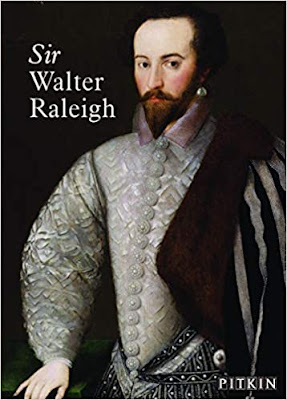This Pitkin historical title provides a brief overview of one man’s ascent from relatively humble origins to international legend. To many, Walter Raleigh was a pirate, traitor, scholar, coloniser, explorer, soldier, poet, adventurer, scientist, cartographer, botanist, fashionista and Favourite of a queen. He is credited with introducing tobacco and potatoes to England. Although not everything he did resulted in success, his exploits never lacked ambition or self-confidence. He left his mark
on England, parts of Europe and America.
A closer look at Raleigh’s connection with Sherborne Castle
Sir Walter Raleigh is one of the best-loved characters of the Elizabethan period. He is credited with introducing tobacco and potatoes. He left his mark on England, parts of Europe and America.
Raleigh sought a house in the West Country. Sherborne Castle was owned by the Bishops of Salisbury. Legend has it that riding by, he pointed it out to his companions. His horse stumbled he and he fell into the mud. Laughing, he said he had taken physical hold of the land he coveted.
Thus it was as exiles that Walter and Lady Raleigh came to live in Sherborne in 1592. The building Raleigh acquired was what we now call the ‘Old Castle’. It had been built in the 12th century and was deemed old-fashioned. Raleigh set about modernising it but soon went over budget. He decided to build a smaller house in the Deer Park, across the valley from the Old Castle.
Raleigh built a new house called Sherborne Lodge, in the latest architectural fashion. He and Bess came to love living at Sherborne and he called it his ‘Fortune’s Fold’. The estate Raleigh acquired from the Bishop comprised several thousand acres of prime agricultural land and Raleigh added to it by purchasing the manors of Pinford and Primsley including Limekiln Farm close to Sherborne. Raleigh’s estate still forms the core of the Digby estate today.
Raleigh proved himself to be a great gardener. Here, he planted many exotic plants brought back from his travels. His garden included pools, canals and waterfalls.
He is credited with popularising tobacco smoking. He is recorded as blowing smoke rings to the delight of Queen Elizabeth. Here in the garden he loved to sit in his Seat and enjoy a quiet pipe. Legend has it that his servant dowsed his master with ale, thinking he was on fire.
Talk also turned to religion and Raleigh was accused of holding a ‘School of the Night’ and spreading non-belief, a crime close to treason at that time. He was put on trial at nearby Cerne Abbas, and acquitted, although the stain on his character remained.
In 1597 he made his will, making provision for his wife and son. In it he expresses his desire to keep his precious estate at Sherborne in his family. On the death of the Queen in 1603, his fortunes declined. The new King, James I, did not trust him and when Raleigh’s name was linked to one of several plots to remove him from the throne, James quickly sent him to the Tower.
The Crown lawyers began looking through his title deeds to Sherborne, and found a vital error in the Trust Deed. They declared that all his possessions were forfeit, including Sherborne. So there could be no doubt, they drew up a Deed of Surrender in 1614:
In 1616 he was allowed on licence out of the Tower to undertake a voyage to find El Dorado in South America. Despite orders to the contrary, his men engaged with Spanish troops, and Wat Raleigh was killed. Returning home a broken man, Raleigh was arrested when he reached Plymouth. On the journey back to London, he took his guards to see Sherborne Castle, telling them that, ‘all this was mine, and it was taken from me unjustly’.
He died under the executioner’s axe in Old Palace Yard on 29 October 1618. Someone in the crowd cried out, “We have not such another head to cut off”.
Maria Wingfield Digby
# # #
About the Author
Maria Wingfield Digby lives in Sherborne Castle, Sir Walter Raleigh’s home, so it is only natural that she should become intrigued with his life and exploits. Four centuries on from his execution she revisits the life of one of the Elizabethan era’s best loved characters. Through the use of the Castle’s original documents and his personal possessions she sheds a new light on this intriguing character. For more information about Sherborne Castle please see http://www.sherbornecastle.com/ and follow on Facebook and Twitter @sherbornecastle







No comments:
Post a Comment
Thank you for commenting